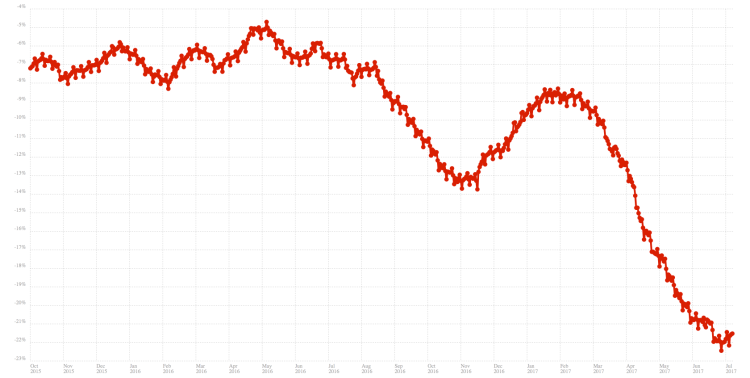Firefox marketshare is in decline and former Mozilla CTO Andreas Gal thinks he knows why.
In a detailed post published on his blog, Gal offers some insight and analysis as to why Mozilla Firefox marketshare is, in his words, ‘falling off a cliff’ and why the trend is probably irreversible.
‘Firefox Desktop is probably headed for extinction’, says former Mozilla CTO
‘Why is Firefox marketshare falling off a cliff?’
Mozilla publishes raw usage data in the form of ‘Active Daily Installs’ (ADIs). Gal, who worked for 7 years at Mozilla, extracted and processed some of this data to see whether the sanguine outlook reported by web observers like StatCounter are accurate.
And, as the graph heading this post shows, the trend downwards appears to be accelerating
But why is Firefox losing the browser wars if, as Gal believes, it is now a better browser than it’s ever been?
He points to two major reasons: the rise of mobile, and the dominance of Google. On this point he expands:
‘Firefox’s decline is not an engineering problem. Its a market disruption’
“This explains why the market share decline of Firefox has accelerated so dramatically the last 12 months despite Firefox getting much better during the same time window. The Firefox engineering team at Mozilla has made amazing improvements to Firefox and is rebuilding many parts of Firefox with state of the art technology based on Mozilla’s futuristic rendering engine Servo. Firefox is today as good as Chrome in most ways, and better in some (memory use for example). However, this simply doesn’t matter in this market.
Firefox’s decline is not an engineering problem. Its a market disruption (Desktop to Mobile shift) and monopoly problem. There are no engineering solutions to these market problems.”
Bleak sounding stuff, isn’t it?
‘Some users are choosing to use older versions of Firefox, skewing the data’
But there may be a reason why this ‘acceleration’ appears so pronounced in the data.
Mozilla Firefox has, over the past year or two, slowly dropped support for users on older operating systems and architectures (e.g., PowerPC). This leaves those users running older builds that do not contribute (AIUI) to the data this graph is derived from.
They’re still using Firefox, but they’re just not being counted.
Relatedly, a number of Firefox users are actively choosing to stick with older versions because of various features being dropped, retired or (in some cases) introduced. Firefox 57, for example, is due later this year and will no longer support legacy Firefox add-ons — and many of these add-ons are a real selling point of Firefox.
But even with these exceptions it seems like Firefox isn’t picking up new users as fast as it’s losing old ones. Does this mean we’re careering to a web monoculture dominated by Chrome?
‘Firefox [is still] used by a huge number of people’
On a somewhat lighter note Andreas says “while Firefox Desktop is probably headed for extinction over the next couple years” (!) it remains a product used by a huge number of people (some 90million) and will continue to to “generat[e] significant revenue for Mozilla for some time.”
90 million users is nothing to sneer at either. Opera, Vivaldi, heck even Microsoft Edge, would love to be as popular as that!
And there’s more to Mozilla than Firefox; in theory, so long as it wants, Firefox doesn’t need to be the worlds most dominant browser™ for them to want to continue to invest in it.
And despite these bleak forecasts Firefox is an open-source project — and anything open-source can never truly die.
